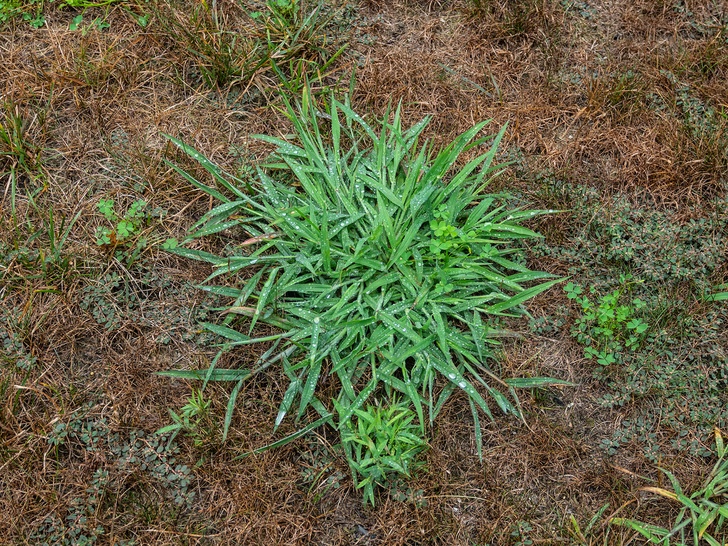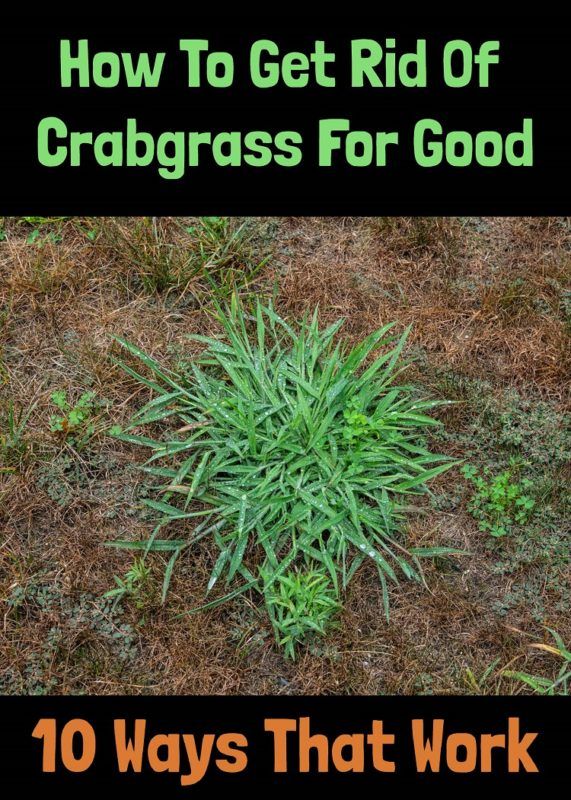
If you have ever planted a flower, a vegetable, or any grass seed in your yard, you have most likely had an unfavorable encounter with crabgrass. This vociferous weed, though seemingly harmless at first, can rapidly take over your garden or yard, creating an untended, unruly looking space.
The problems associated with crabgrass are not just aesthetic, however. This weed sucks massive amounts of nutrients and water from the soil, stealing life-giving necessities from your more delicate plants to continue its unprecedented take-over. It appears in late spring, sprouting up in any area of bare soil. Since it is an annual, it will leave ugly bare spots in your lawn when it dies in the winter. Crabgrass also roots incredibly deep into the ground, making it one of the most challenging weeds to remove just by pulling.
Crabgrass spreads like wildfire, with one plant able to produce 150,000 seeds. These seeds stick around in the soil for up to 3 years, germinating when the ground warms, and moisture reaches them. If this problem is left unattended, you will soon be facing an outbreak, or a yard made up entirely of this stubborn grass. Rather than treating this as a standard weed issue, particular attention must be given to eradicate it once and for all.
What Does Crabgrass Look Like?
Generally, an infestation of crabgrass is relatively apparent. It tends to look different from the rest of your grass, or it begins appearing after the rest of the lawn has already sprouted for the season. If this sounds familiar, but you are unsure if it is crabgrass that is plaguing your yard, it’s best to get a closer look. Don’t be afraid up close and personal with the weed for more clear identification.
Crabgrass often looks like a small cornstalk when it is first growing, with leaves about the same width as a pencil. This makes it easy to spot as it is often much wider than typical grass varieties. This original upshoot quickly sends off many side shoots and begins to spread, with leaves coming off in a “Y” from the original blade. As crabgrass reaches later stages, the blades start growing sideways, and more roots begin digging into the ground. This often makes the weed appear to have a star shape at the primary source.
Once you are confident that crabgrass is your irritating foe, you can begin the process of weed obliteration and lawn restoration.
10 Effective Ways To Get Rid Of Crabgrass For Good
Now that you’ve established a need for crabgrass control, you may be thinking that chemical-laden weed-killers are your only option. Wait a minute before grabbing that bottle of weed-killer, however. Toxic herbicides not only harm your garden and the grass in the surrounding area but also can be incredibly detrimental to your health and that of your pets. A beautiful lawn isn’t worth the risk of chemical side-effects and adverse conditions.
In fact, a recent study published JAMA shows the harmful effects of the popular weedkiller Roundup on the systems of older individuals who have been exposed to this chemical. The study found that in animals and humans “chronic exposure to glyphosate-based herbicides can induce adverse health outcomes.”
There are always better options when it comes to weed control, and chemicals, though usually effective, do more harm than good.
Here a few methods useful for deterring crabgrass and making your yard inhospitable to this persistent weed.
1. Catch It Early
The longer you allow a crabgrass outbreak to continue, the more difficulty you will have containing and controlling its spread. If you have had any trouble in the past, or are concerned about the threat of crabgrass in your lawn or garden, take preventative steps immediately. Consider investing in an organic post-emergent weed control herbicide that will not harm your plants or turf. Most post-emergent crabgrass killers are chemical based, and this is one of the only organic crabgrass killers on Amazon. It has mixed reviews and seems to work brilliantly for some and without success for others.
Remember, pre-emergents must be applied before the soil has warmed sufficiently for crabgrass germination. Apply these organic herbicides before soil temperatures reach or exceed 50 degrees Fahrenheit to kill the weeds before they can grow.
2. Pull It Out
This back to basics solution is particularly helpful when crabgrass has taken residence in flower or vegetable beds and can be easily identified. Wait until the ground is softened from rain and grab the weed at its base, twisting and pulling it by the roots. If the crabgrass is incredibly stubborn, use a heavy duty weeding tool such as this 3 claw stand up weeder to tear it up entirely.
If you are incredibly determined and patient, you can divide your lawn into sections and pull out crabgrass clumps by hand. Enlist the help of your family members and spend a few minutes each evening tackling the unruly grass. You will be surprised at how effective this method is. Plus, all your hard work will be worth it in the long run when you have a weed-free yard.
3. Wait Longer To Mow
Though a short lawn is often the key to your curbside appeal, you may have to tolerate longer grass for the sake of your yard’s health. Crabgrass thrives on light and moisture, and when longer grass shades it, it is unlikely to be as determined. Leave your grass until it is about 2-3 ½ inches before mowing.
4. Focus On Lawn Health
Sometimes the best method to handle crabgrass in the yard is to prevent it from growing in the first place. Take time to cultivate a healthy, full lawn. This includes picking the type of grass seed that best suits your region and soil type. Since crabgrass is so attracted to bald spots, you can often keep it from sprouting by paying particular attention to the trouble areas of your yard.
Fertilizing as required by the type of grass seed in your lawn can lead to a lush bed of grass that leaves no room or nutrients for crabgrass growth. Follow fertilizer instructions and repeat as directed.
5. Prevent Seed Spread
Since crabgrass is so easily spread, you should take measures to ensure that the seeds from your weed pulling efforts are contained. Bag and dispose of all your weeds immediately. Avoid putting weeds in any compost bins as this can lead to seed distribution issues.
6. Change Your Watering Schedule
Often, people make the mistake of watering their turf frequently with a light sprinkling. This not only harms your grass by encouraging shallow root growth, but it also makes the environment more desirable for crabgrass. Water your lawn deeply every couple of days, or as often as needed to allow time for the soil to dry out.
7. Mulch Garden Beds
Though crabgrass is very invasive, it’s not very hardy. Merely providing a thick layer of mulch for the crabgrass to fight through is often very effective when struggling with this weed in your flower bed. When conditions are not favorable, the nuisance weed usually gives up, and the seeds do not germinate.
8. Lay Down Landscape Fabric
While this is only possible in the formation of new garden beds, it is an excellent tip to keep in mind as you expand your planting area. Cover the barren ground in a layer of landscape fabric before planting and mulching to smother weeds in their tracks.
9. Boiling Water
Pouring boiling water on the areas affected by crabgrass may prove useful, however, keep in mind that this method generally kills everything that is exposed to it. Not just the troublesome crabgrass, but the plants or lawn in the surrounding areas as well. There are a few types of grass such as Bermuda or St. Augustine that may survive the boiling water treatment, but you should always test on a discreet area of the yard first. This may be a better option for isolated areas of crabgrass infestation rather than a lawn-wide dilemma.
10. Start Over
Though by far the most desirable option, if your crabgrass infestation has reached such a severe level that it has overtaken more than 50% of your healthy grass, or all of your weed-fighting methods are proving ineffective, you may have to bite the bullet and get a fresh start on your lawn.
If you are ready to take such drastic measures and feel that you’ve expended all other options. You will want to kill your entire lawn with an organic, non-selective herbicide. Make sure to protect any flowers or healthy grass by covering it with plastic or setting up a cardboard wind barrier. Wait until late summer to complete this process, as this is the best time for successful reseeding. Make sure to wait a few days and then get new grass seed on your lawn as soon as possible. This could be an excellent opportunity to switch to a different grass variety or get a fresh start for optimal lawn health.
Make sure that you are implementing all crabgrass prevention procedures from this point forward to avoid any more infestation issues.
Crabgrass is one of the major threats to the health and beauty of your lawn and garden. Are you going to sit back and let this weed run your yard? Take action today to reclaim your outdoor living space.
Pin This To Save For Later

